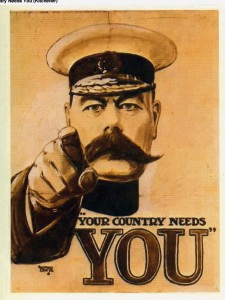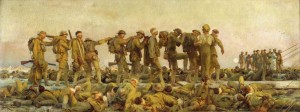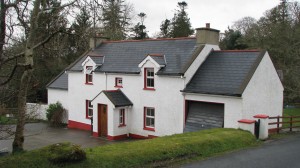‘It’s a long way to Tipperary’: the mystery of the medal
Published in 18th-19th Century Social Perspectives, Features, Issue 1 (January/February 2015), Volume 23
Above: : One of Lord Kitchener’s famous First World War recruiting posters. Years earlier Kitchener had been a guest of the widow of John George Adair at Glenveagh Castle, close to Benny Gallagher’s house.
Irish politicians began fighting for tenants’ rights and for Home Rule, trying to ensure that such famines and evictions would never happen again. Adair was to die suddenly in America and Mrs Adair, who was much kinder than her late husband, took over his estate and introduced red deer. One guest whom she invited for a hunting holiday was Lord Kitchener, who was to take charge of the British forces during the Great War.
First World War

Gassed by John Singer Sargent. Philip Hynes’s younger brother, Edward, was the victim of such a gas attack in July 1915. He never got over the effects and died from his injuries in 1921. (Imperial War Museum)
Home Rule was about to become law when the First World War broke out. The British Army needed many recruits, so Lord Kitchener introduced his famous poster, pointing a finger and announcing that ‘Your country needs you’. Two who joined were Philip Hynes and his brother Patrick from outside Nenagh, Co. Tipperary, while another younger brother, Edward, was to join up later on. They joined the Leinster Regiment and were training in Cork when the war began. Their regiment was immediately sent to help stop the German advance towards the coast so that they could control the ports there. The British managed to win this ‘race for the coast’. This resulted in two armies facing each other along a Western Front stretching from the sea to the Alps.
The Leinster Regiment was ordered to capture the French town of Armentières, where there was a bulge in the British line, from the Germans. They managed to do so in fierce fighting, although Hynes lost 685 of his comrades. The square in Armentières became known as ‘11 o’clock square’ because the town clock stuck at this time following German shelling. Both sides began to dig in and to make trenches, with ‘No Man’s Land’ between.
Christmas truce
After Christmas, the trench warfare resumed. The Leinster Regiment was sent to the area around Ypres, where there was fierce fighting. On 14 July 1915 the Germans tried chlorine or mustard gas for the first time and they forced a breakthrough in the line close to the Leinster Regiment section. They advanced within two miles of Ypres. Many soldiers died a horrible death breathing in this gas. Poor Edward Hynes was badly affected and had to be sent home. He never got over the effects of the gassing and died from his injuries in 1921.
‘Liquid fire’
In response, the British dug their first tunnel bomb of the war under the German lines at Hooge nearby, packed it with explosives and blew it up, creating a huge crater. It killed hundreds of Germans and the Allies were then able to recapture the area. The Germans retaliated with flamethrowers, which were also being used for the first time in this war. Philip Hynes and his fellow soldiers witnessed this ‘liquid fire’ attack from their raised position. With all these attacks and counter-attacks, Hynes’s section of the front line, close to the Hooge crater, was a total mess, littered with bodies from both sides, as it was too dangerous to bury them.
Philip Hynes was a trained bomber or grenade-thrower, whose job it was to run down whatever trench they were attacking and fire his grenades into dugouts as he passed. On 15 August his part of the trenches came under heavy shelling for a couple of hours, which set off a box of their grenades. When this bombing had ceased, Hynes was amongst those who had been killed. He was buried at his regiment’s dressing station at Birr Cross, which would later become a cemetery. Within days his mother received a letter beginning ‘We regret to inform you . . .’. No wake or funeral was held at his home, as there was no corpse. The family did, however, have a Mass card made. To date, no family member has ever had the opportunity of visiting his grave in Belgium.
1916 Rising
With the British army busy fighting in Europe, Irish republicans seized the opportunity to stage a rebellion in Dublin in 1916. It was a ‘heroic failure’ and many locals were furious with them because of the destruction caused and also because many of their husbands were away fighting in the Great War. But then fifteen of the leaders were executed and suddenly they had become heroes. To many Irish people the British were now the enemy and they wanted to break free. After the Rising, the now elderly Mrs Adair thought it unsafe to come back to Glenveagh, but she made her castle available to Belgian soldiers as a rest home. In gratitude they created a path there which is still known as the ‘Belgian Walk’.
In November 1918 the war finally ended and all the Irish soldiers returned home. But they were coming back to a very different Ireland. Instead of coming back as heroes, to many they were now seen as traitors who had been fighting for the ‘enemy’. Patrick Hynes had survived the war but he had to come home without his dead brother Philip. He had seen many terrible things during his five years’ fighting and his brother Edward was also now desperately ill. But it was better to say nothing and just try to get on with life. The year after the war, his mother was presented with Philip’s 1915 Star medal.
War of Independence
A terrible war for independence had now begun, mainly against the dreaded ‘Black and Tans’, many of whom had fought in the Great War and who had been drafted in to help. The IRA started using ‘hit and run’ tactics, as they had learned that they could never beat the British in open warfare. One person who joined these ‘flying columns’ was Philip Hynes Jr, nephew of the dead soldier. He was part of the IRA’s 4th Tipperary Battalion, constantly moving from safe house to safe house.
By the end of 1921 both sides were exhausted, and they agreed on a treaty that would give Ireland a Free State of 26 counties, but they would not have the North and would have to swear allegiance to the king. The Dáil split into two groups, those who were pro-treaty (‘Free Staters’) and those who would not accept it (‘Irregulars’). Soon another war had broken out between former friends and colleagues.
Civil War
The Free Staters were very strong in Donegal and so a group of Irregulars were sent from the stronger counties in Munster to help. One of these men who headed northwards was Philip Hynes Jr. Before he left, he either took or was given his uncle’s war medal as a good-luck charm. He headed for Glenveagh Castle, which the Irregulars had made their base because it was so easily defended. They also took control of the surrounding gate lodges, along with ‘Lady Mary’s house’ below Benny Gallagher’s. Benny’s granny remembered the Irregulars from this big house coming up to ask for milk and food each morning. Philip Hynes was stationed in this house and at some stage he dropped the medal, which was not to be found again for almost a century.
Both sides agreed to hold peace talks in Churchill village, close to Glenveagh Castle, but they could not agree. As the Free State officers, including Joe Sweeney, were leaving, a couple of the Irregular hotheads wanted to murder them. But their captain, Charlie Daly from Cork, got to hear of their intentions and so he put four of his men on the runners of the car until it was safely out of the area. A short time later some of the soldiers from the castle ambushed a Free State lorry, killing two and injuring many others. Feelings were now running high. The Free Staters began to bring up a large cannon to force the Irregulars out of the castle, but before it arrived the Irregulars had scarpered.
In the House of Commons the minister for the colonies was soon answering questions about what was happening in Glenveagh. His name was Winston Churchill; he had been part of the British team during the treaty talks and twenty years later he would lead Britain during World War II. His answers to the questions show very clearly that Ireland was now separated from Britain and in charge of its own affairs:
‘Colonel Gretton: Asked the Secretary of State for the Colonies whether his attention had been called to a report from West Donegal, stating that parties of Irregulars from Glenveagh Castle in motorcars had visited a number of farmhouses in the Churchill and Termon districts and conscripted about 11 young women, whom they brought with them to the castle to act as domestic servants for those that are in occupation there; that the mother of one of the girls, who vigorously protested against the taking away of her daughter, was placed in a motorcar and driven away a few miles, after which she was put out on the roadside, and the car resumed its journey to the castle; and whether in view of recent outrages on women in Ireland, what steps have been taken, or will be taken, to secure the release of these young women?
Mr Churchill: My attention has been drawn to a newspaper report of this outrage, but I am unable to vouch for its accuracy. In any case, the matter would appear to be one for the Provisional Government to deal with, and I am glad to observe that, according to the latest reports, their troops have now compelled the evacuation of Glenveagh Castle, and are steadily extending their control over County Donegal.
Lt. Colonel Dalrymple White: Will not the right hon. gentleman take further steps in this case, in view of the fact that the outrages occurred in the Churchill district?
Churchill: That is a joke, I suppose?
Gretton: Has the right hon. gentle-man made no inquiry and taken no steps to secure the arrest of these people and the release of those who have been kidnapped?
Churchill: This happened in one of the 26 counties, and if Irish girls are kidnapped and carried off under such atrocious conditions by violent persons, in my opinion it is for the Irish men to see that they are released; and that is what is being done.
Colonel Ashley: Is the right hon. gentleman now quite satisfied with that policy?
Churchill: I am increasingly satisfied.’
Epilogue
The Irregulars from the castle were now on the run, but Daly’s column was captured and four of them were executed, including Daly himself. Commander Sweeney probably had no idea that Daly had saved his life in Churchill just a few months before. Shortly after these executions a ceasefire was called and Philip Hynes Jr returned home to Tipperary, but without his medal. Mr McElhinney, the last private owner of Glenveagh Castle, would eventually leave the estate, including the evicted Derryveagh section, to the people of Ireland. Birr Cross Cemetery, where Philip Hynes is buried, is halfway between Hooge crater, now a lake, and ‘Hellfire Corner’, once known as ‘the most dangerous place on Earth’ and nowadays a roundabout. This cemetery is less than two miles from the Menin Gate at Ypres, where there is a large memorial to all the soldiers who have no known resting place. Every night at eight, the road is closed and The Last Post is played. On a still night you can hear this bugle at Birr Cross. But ‘it’s a long way to Tipperary’.
The medal will shortly be presented back to the Hynes family in time for the 100th anniversary of Philip’s death, along with a copy of his medal’s story.
Read More: The medal
Decade of Centenaries all-island schools’ history competition 2015

















